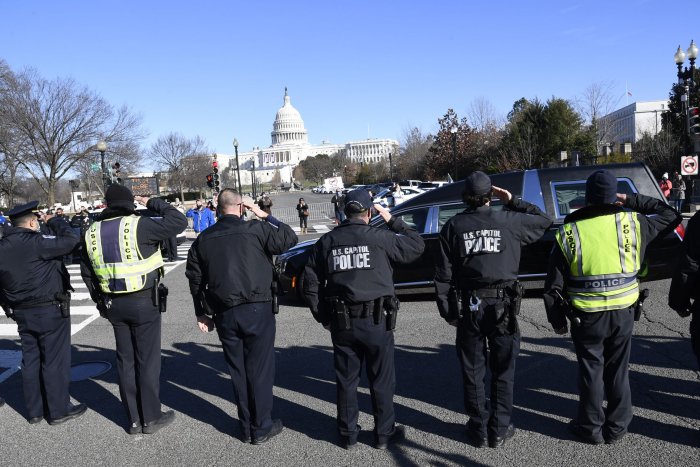1 of 5 | Army Maj. Gen. William Walker, commanding general of the District of Columbia National Guard, answers questions Wednesday during a Senate homeland security and rules joint hearing to discuss the January 6 attack on the U.S. Capitol in Washington, D.C. Pool Photo by Greg Nash |
License Photo
March 3 (UPI) -- National security officials disagreed on the speed of response to the Jan. 6 attack on the U.S. Capitol during questioning Wednesday as part of the Senate's investigation of the assault.
Maj. Gen. William Walker of the District of Columbia National Guard and Pentagon official Robert Salesses presented differing timelines for when Walker received approval to deploy the National Guard in response to radical supporters of former President Donald Trump who forced their way into the Capitol building. They appeared before a joint hearing of the Senate homeland security and rules committees.
Walker testified that it took more than 3 hours to authorize the deployment of troops in response to the insurrection, as Secretary of the Army Ryan McCarthy did not give the D.C. National Guard pre-emptive "quick response" authority for the day of the attack, which Walker said he found "unusual."
"So, no civil disturbance equipment could be authorized unless it came from the secretary of defense," he said. "The secretary of defense told me I needed his permission to escalate to have that kind of protection."
Were it not for the additional restrictions, Walker said he would have "immediately pulled all the guardsmen that were supporting the Metropolitan Police Department."
"They had the gear and the vehicles," he said. "I would have had them assemble in the armory and then get on buses and go straight to the armory and report to the most ranking Capitol Police officer they saw and take direction and futher."
He added that 155 guardsmen could have been sent to the Capitol shortly after 2 p.m. and "could have helped extend the perimeter and push back the crowd."
At 1:49 p.m. on the day of the riot, Walker described receiving a "frantic" call from then-U.S. Capitol Police Chief Steven Sund saying that his "voice was cracking with emotion, indicating that there was a dire emergency at the Capitol and he requested the immediate assistance of as many available National Guardsmen that I could muster."
Walker said that he quickly relayed the request to senior Pentagon officials but said Army senior leaders "did not think it would look good" to send troops to the Capitol, worrying it could further incite the mob.
"The approval for Chief Sund's request would eventually come from the acting secretary of defense and be relayed to me by Army senior leaders at 5:08 p.m. -- 3 hours and 19 minutes later," Walker said.
Salesses presented a different timeline from Walker, saying that after a 2:30 p.m. call with military officials, McCarthy assessed what the National Guard's mission would be and visited the headquarters of the D.C. Metropolitan Police Department at 4:10 p.m. before securing final approval from acting Defense Secretary Christopher Miller at 4:32 p.m.
He said news of the approval was not delivered to Walker until 5:08 p.m., citing a communication issue.
The first part of the committees' investigation occurred last week when the panel heard testimony from four law enforcement and security officials, including Sund.
Tuesday, FBI Director Christopher Wray told the Senate judiciary committee the assault was planned and grew out of extremism online via social media.
Jill Sanborn, assistant director of the FBI's counterterror division, provided additional details about the FBI's response to the riot on Wednesday, testifying that tactical teams responded to reports of explosives placed near the headquarters of the Republican and Democratic parties.
"In 2020, the FBI assessed the greatest terrorism threat to the homeland was from lone actors or small cells who typically radicalize online and look to attack soft targets with easily accessible weapons," Sanborn said in her opening remarks.
"We remain confident in that assessment today."
Melissa Smislova, senior official performing the duties of the under secretary at the Homeland Security Department's Office of Intelligence and Analysis, testified Wednesday that the Jan. 6 riot could inspire future terrorist attacks.
The Pentagon also warned in a report Tuesday that domestic extremist groups have sought to recruit members of the U.S. military, and even join the armed forces themselves to obtain combat training.
"Despite a low number of cases in absolute terms, individuals with extremist affiliations and military experience are a concern to U.S. national security because of their proven ability to execute high-impact events," the report states.
The report was not a result of the Capitol attack, but was rather commissioned by Congress last year. Nonetheless, analysts and officials say it is directly relevant to the forces that spurred the Jan. 6 assault that caused five deaths, including that of a Capitol Police officer.
Merrick Garland, President Joe Biden's nominee for U.S. attorney general, has said prosecuting the people responsible for the attack will be a top priority of his tenure at the Justice Department. His nomination was approved by the Senate judiciary committee this week and is expected to receive confirmation soon in a full Senate vote.
Capitol Hill police salute the passing of the funeral hearse on Sunday for slain Officer Brian Sicknick, who died in the rioting at the U.S. Capitol on Wednesday. Photo by Mike Theiler/UPI |
License Photo
















